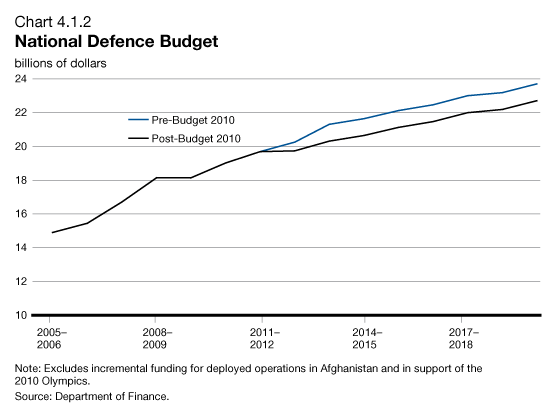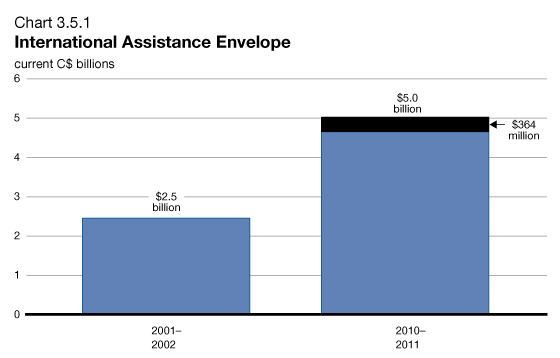Common menu bar links
Archived - Budget 2010: Leading the Way on Jobs and Growth
Introduction
Actions taken under Canada’s Economic Action Plan have helped our country through the global recession. While a recovery has begun, it remains fragile and too many Canadians are out of work.
Budget 2010 builds on the stimulus introduced in Year 1 of Canada’s Economic Action Plan, and invests in new measures to create jobs and economic growth.
Budget 2010 also includes a three-point plan to return to balanced budgets once the economy recovers.
Year 2 of the Economic Action Plan
Budget 2010 confirms the second year of Canada’s Economic Action Plan with $19 billion in new federal spending to protect and create jobs, strengthen Canadian innovation, and build a strong foundation for Canada’s future. This includes:
- $3.2 billion in personal income tax relief.
- $7.7 billion in stimulus to modernize infrastructure, support home ownership and improve social housing across Canada.
- $1.9 billion for post-secondary education and research, technology and innovation, and environmental protection.
- $2.2 billion to support industries and communities hardest hit by the economic downturn.

Budget 2010: Creating Jobs and Growth
Budget 2010 takes targeted action to create and protect jobs, and drive economic growth today and for the future.
Major actions have been taken to create and protect jobs
Youth Employment
Budget 2010 supports young Canadian workers through internships and skills development to help them find jobs. This includes:
- $30 million to promote internships under Career Focus.
- $30 million for Skills Link to assist more young Canadians while the labour market recovers.
- $20 million in support of Pathways to Education Canada’s work with communities to support disadvantaged youth.
- $10 million in new funding for the Canadian Youth Business Foundation to supprt young entrepreneurs.
Protecting Jobs and Supporting the Unemployed
Budget 2010 continues measures introduced in Canada’s Economic Action Plan to help unemployed Canadians with:
- Over $4 billion to help unemployed Canadians find new and better jobs, including up to five extra weeks of regular Employment Insurance (EI) benefits and greater access to regular EI benefits for long-tenured workers.
- A temporary extension of work-sharing agreements to a maximum of 78 weeks.
Creating Economic Growth and Jobs Through Innovation
Budget 2010 takes action to harness Canadian innovation for competitive advantage in the economy of the future, including:
- $45 million to establish a new post-doctoral fellowships program.
- $222 million for research at the TRIUMF nuclear and particle physics facility in British Columbia.
- $32 million per year increase for Canada’s research granting councils.
- $8 million per year increase for the Indirect Costs of Research program.
- $75 million for Genome Canada to support genomics research.
- $9 million to support the Rick Hansen Foundation for spinal cord research.
- $15 million increase per year to double the budget of the College and Community Innovation Program.
- $135 million for the National Research Council’s regional innovation clusters program.
- $48 million to explore new avenues for the production and use of medical isotopes.
- $497 million to the Canadian Space Agency to develop the Radarsat Constellation Mission.
- $40 million to launch a new Small and Medium-sized Enterprise Innovation Commercialization Program to support up to 20 demonstration projects.
- $8 million to extend the International Science and Technology Partnerships Program.
- $49 million increase in annual funding for regional development agencies to support innovation across Canada.
Encouraging Investment and Trade
Budget 2010 takes action to improve conditions for investment, enhanced competition, and reduce barriers for businesses. These actions include:
- Making Canada a tariff-free zone for industrial manufacturers by eliminating all remaining tariffs on manufacturing inputs and machinery and equipment, expected to create 12,000 jobs over time.
- Improving Canada’s system of international taxation – including by eliminating tax reporting under section 116 of the Income Tax Act for many investments, therby enhancing the ability of innovative high-growth Canadian business to attract foreign venture capital.
- Establishing a new Red Tape Reduction Commission to reduce paperwork for businesses.
- Increasing competition in telecommunications by removing existing restrictions on foreign ownership of Canadian satellites.
- $7.2 million for a new Catch Certification Office to support the seafood industry.
- Extending the temporary 15-per-cent Mineral Exploration Tax Credit to support the mining sector.
- $51.7 million to support the operations of the Canadian Grain Commission.
Building a Greener Economy
Budget 2010 takes action to enhance Canada’s environmental sustainability and create a greener economy with:
- $100 million for the Next Generation Renewable Power Initiative to support advanced clean energy technologies in the forestry sector.
- Modernizing the regulatory system for project reviews, and supporting consultations on major resource projects.
- Expanded tax support for investments in clean energy generation technology.
- $11 million for meteorological and navigational services in the Arctic.
- $18 million to sustain the Government’s annual reporting on environmental indicators.
Modernizing Canada’s Infrastructure
Budget 2010 strengthens the Government’s commitment to rebuild Canada’s aging infrastructure with:
- $175 million to renew Marine Atlantic’s fleet and shore facilities and improve its services.
- $28 million to ensure Atlantic ferry services continue to operate in a safe and reliable condition.
- $10 million over three years to support advance work on the Detroit River International Crossing in Windsor, Ont.
- $51 million to The Jacques Cartier and Champlain Bridges Incorporated to service Montréal's bridges.
- $32 million to support regional and remote passenger rail services.
- $87 million to ensure the Canada Border Services Agency can continue to deliver efficient and secure border services.
- $38 million to implement a comprehensive air cargo security system.
- New funding for the Canadian Air Transport Security Authority.
- $27 million for a new hovercraft for the Coast Guard's Sea Island base near Vancouver.
- $330 million to extend the First Nations Water and Wastewater Action Plan.
Strengthening the Financial Sector
Budget 2010 will support Canada’s strong and competitive financial sector with:
- Moving toward establishing a Canadian securities regulatory authority within three years.
- Legislation setting out a framework for covered bonds to help financial institutions diversify their sources of funding.
- A code of conduct for credit and debit card networks.
- Enhanced financial consumer protection measures through improved disclosure and business practices.
- Modernizing Canada's currency with new material for bank notes and a new production method for $1 and $2 coins.
- A task force to review the safety, soundness and efficiency of Canada’s payments system.
- A legislative framework to enable credit unions to incorporate federally to broaden choices for consumers.
- $8 million a year to help the Financial Transactions and Reports Analysis Centre of Canada meet its growing responsibilities.
Protecting Canadian Families and Communities
- $6.6 million to enhance the existing federal Victims of Crime Strategy, including facilitated access to EI sickness benefits for eligible workers who have lost a family member due to a crime.
- $14 million over two years to increase the ability of police forces to process DNA samples.
- $28 million to the Canadian Security Intelligence Service.
- $8 million to establish a new civilian independent review and complaints commission for the RCMP.
Supporting the Vulnerable
Budget 2010 takes action to improve the quality of life for vulnerable Canadians and their families with:
- $5 million in annual tax relief to make the tax treatment of the Universal Child Care Benefit fairer for single-parent families.
- $95 million over two years in additional support for Registered Disability Savings Plans to allow more flexibility in making contributions.
- A reduction in red tape for charities to help them do their job.
- An additional $45 million for the Enabling Accessibility Fund to remove barriers for Canadians with disabilities.
- $53 million to further improve First Nations child and family services.
- $199 million to help former students of the Indian residential school system.
- $10 million to combat violence against Aboriginal women.
Investing in a Healthy North
Budget 2010 makes strategic investments that will address key health care challenges for Northerners with:
- $45 million to give Northerners in isolated communities better access to affordable healthy food.
- $60 million to facilitate transformation of health systems in Canada’s three territories.
Standing Up for Those Who Helped Build Canada
- $2 million for a Community War Memorial Program.
- Facilitated access for EI sickness and parental benefits to help Canadian Forces members and their families.
- $10 million for the New Horizons for Seniors Program.
Encouraging Participation in Amateur Sport
- $44 million to support Canada's elite summer and winter athletes.
- $10 million to the Canadian Paralympic Committee to build on the success of our Paralympians.
- $2 million to Special Olympics Canada for intellectually disabled Canadians.
- $6 million to ParticipACTION to promote healthy lifestyles and fitness for Canadians.
Honouring Canada’s International Commitments
Budget 2010 delivers on Canada’s commitment to double international assistance with:
- Increased international assistance funding of $364 million for a total of $5 billion.
- $800 million of loan resources and $40 million in subsidy resources to support the world’s poorest countries.
The Plan to Return to Budget Balance
Budget 2010 charts a course to bring Canada’s finances back to balance long before any other Group of Seven (G7) countries with a disciplined, three-point plan.The Three-Point Plan to Return to Budget Balance
- Follow through on the Economic Action Plan's "exit strategy" to wind down the temporary spending measures as planned.
- Restrain government spending through targeted measures.
- Review government administrative functions and overhead costs to identify additional savings and improve service delivery.
The Government will not raise taxes and will not cut major transfers for health care, education and pensioners.
Budget 2010 proposes $17.6 billion in savings over five years, including:
- Putting the growth of the National Defence budget on a more modest path, after years of significant and necessary investments in Canada’s military capabilities. This will result in projected savings of $525 million in 2012–13 and $1 billion annually beginning in 2013–14.

- After successive yearly 8-per-cent increases to bring the total foreign aid budget to a record high $5 billion per year in 2010–11, assessing future International Assistance Envelope spending levels on a year-by-year basis in the budget going forward. This will result in projected savings of $438 million in 2011–12 relative to planned spending, rising to $1.8 billion by 2014–15.

- Freezing the salaries of the Prime Minister, Ministers, Members of Parliament and Senators for 2011–12 and 2012–13.
- Reallocating department operating budgets to fund the 1.5-per-cent annual increase in public sector wages.
- Freezing operating budgets for 2011–12 and 2012-13 at their 2010–11 level.
- Reallocating funds identified in strategic reviews to reduce the budgetary deficit.
- Streamlining the delivery of government services to reduce costs and reviewing corporate assets.
- Reducing the number of Governor in Council positions by 245.
- Introducing measures to close tax loopholes and protect the integrity of the tax system, expected to yield $355 million in savings in 2010–11, rising to $625 million by 2014–15.
As a result of the expiration of the Economic Action Plan and the measures in this budget, the deficit is projected to decline by about one half over the next two years to $27.6 billion, and by two-thirds by 2012–13 to $17.5 billion. By 2014–15, the deficit is projected to be $1.8 billion.
